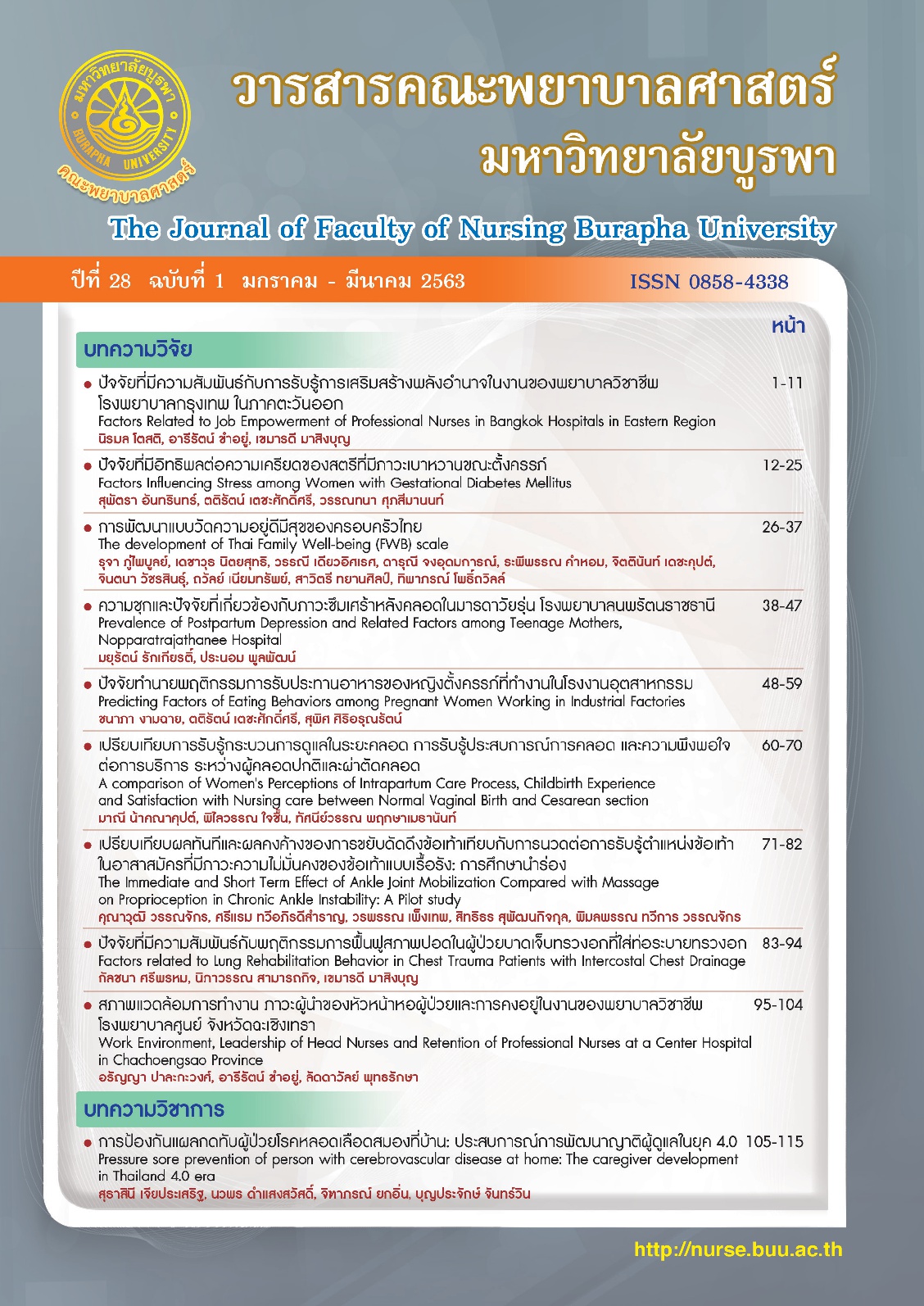เปรียบเทียบผลทันทีและผลคงค้างของการขยับดัดดึงข้อเท้าเทียบกับการนวดต่อการรับรู้ตำแหน่งข้อเท้าในอาสาสมัครที่มีภาวะความไม่มั่นคงของข้อเท้าแบบเรื้อรัง: การศึกษานำร่อง
คำสำคัญ:
การขยับข้อต่อ, การนวด, ความไม่มั่นคงของข้อเท้าแบบเรื้อรังบทคัดย่อ
บทคัดย่อ
การรักษาภาวะความไม่มั่นคงของข้อเท้าแบบเรื้อรังโดยการขยับดัดดึงข้อต่อ การนวดและการยืดกล้ามเนื้อสามารถลดความคลาดเคลื่อนของการรับรู้ตำแหน่งของข้อต่อ เพิ่มช่วงการเคลื่อนไหว และเพิ่มคะแนนแบบประเมิน Foot and Ankle Ability Measure-Sport (FAAM-S) ในผู้ที่มีภาวะความไม่มั่นคงของข้อเท้าแบบเรื้อรังได้ แต่ยังไม่มีการศึกษาเปรียบเทียบผลทันทีและผลคงค้างระหว่างการขยับดัดดึงข้อต่อและการนวดว่าสามารถให้ผลที่เทียบเคียงกันได้หรือไม่ การวิจัยนำร่องนี้มีวัตถุประสงค์ เพื่อเปรียบเทียบผลทันทีและผลระยะสั้นระหว่างการขยับดัดดึงข้อต่อและการนวดต่อการเปลี่ยนแปลงของค่าความคลาดเคลื่อนของการรับรู้ตำแหน่งของข้อต่อในผู้ที่มีภาวะความไม่มั่นคงของข้อเท้าแบบเรื้อรัง อาสาสมัครที่มีภาวะความไม่มั่นคงของข้อเท้าแบบเรื้อรัง จำนวน 10 คน ได้รับการสุ่มเข้า กลุ่มที่รักษาด้วยการขยับดัดดึงข้อต่อ 5 คน และกลุ่มที่รักษาด้วยการนวด 5 คน อาสาสมัคได้รับการประเมินขนาดค่าความคลาดเคลื่อนของการรับรู้ตำแหน่งของข้อโดยเครื่องมือวัดมุม องศาการเคลื่อนไหวของข้อเท้าในทิศทางกระดกข้อเท้าขึ้น ที่ช่วงเวลา ก่อน หลังทันที และหลังการรักษา 10 นาที
ผลการศึกษาพบว่า การขยับดัดดึงข้อต่อและการนวดสามารถเพิ่มความแม่นยำของการรับรู้ตำแหน่งของข้อต่อได้อย่างมีนัยสำคัญทางสถิติ (p < .05) ทั้งสองกลุ่ม ทั้งในผลทันทีและผลคงค้าง แต่การขยับดัดดึงข้อต่อสามารถเพิ่มความแม่นยำของการรับรู้ตำแหน่งของข้อต่อได้ดีกว่าการนวด การรักษาทั้งสองวิธีนี้ไม่สามารถเพิ่มค่าคะแนน FAAM-S ได้อย่างมีนัยสำคัญทางสถิติ (p > 0.05) การรักษาทั้งสองวิธีอาจจะนำไปเป็นการรักษาร่วมในการรักษาทางกายภาพบำบัดในผู้ที่มีภาวะความไม่มั่นคงของข้อเท้าแบบเรื้อรังเพื่อเพิ่มความแม่นยำของการรับรู้ตำแหน่งของข้อและเพิ่มช่วงการเคลื่อนไหวในการกระดกข้อเท้าได้
เอกสารอ้างอิง
Diaz D, C., Vega R, L., & Perez, M. C, O. (2014). Effects of joint mobilization on chronic ankle instability: A randomized controlled trial. Journal Disability and Rehabilitation, 37(7): 601-610.
Docherty, C, L., & McLeod, V. (2006). Postural Control Deficit in Participants with Functional Ankle Instability as measured by the Balance Error Scoring System. Clinical Journal of Sport Medicine, 16(3): 203-208.
Denegar C, R., Hertel, J., & Fonseca, J. (2002). The effect of lateral ankle sprain on dorsiflexion range of motion, posterior talar glide, and joint laxity. J Orthop Sport Phys Ther, 32(4): 166–173.
Drust, B., Atkinson, G., & Gregson, W. (2003). The effects of massage on the intramuscular temperature in the vastus lateralis in humans. International Journal Sports Medicine, 24: 395-399.
Erik, A., Wikstrom., Kyeongtak, Song., & Lea, A. (2017). Comparative effectiveness of plantar-massage techniques on postural control in those with chronic ankle instability. Journal of Athletic training, 52(7): 629-635.
Green, T., Refshauge, K., & Crosbie, J. (2011). A randomized controlled trial of a passive accessory joint mobilization on acute ankle inversion sprains. Phys Ther, 81: 984-994.
Greenman, P.E. (1996). Principles of Manual Medicine. Baltimore: Williams & Wilkins.
Gribble, P. A., Delahunt, E., & Bleakley, C M. (2013). Selection criteria for patients with chronic ankle instability in controlled research: a position statement of the International Ankle Consortium. J Orthop Sports Phys Ther, 43(8): 585–591.
Hertel, J. (2002). Functional anatomy, pathomechanics, and pathophysiology of lateral ankle instability. J Athl Train, 37(4), 364–375.
Hoch, M. C., & McKeon, P. O. (2010). Joint Mobilization Improves Spatiotemporal Postural Control and Range of Motion in Those with Chronic Ankle Instability. Journal of Orthopedic Research, 29(3), 326-332.
Hoch, M. C., & McKeon, P. O. (2011). Joint mobilization improves spatiotemporal postural control and range of motion in those with chronic ankle instability. J Orthop Res, 29, 326-332.
Hoch, M. C., Andreatta, R. D., & Mullineaux, D. R. (2012). Two-Week Joint Mobilization Intervention Improves Self-Reported Function, Range of Motion, and Dynamic Balance in Those With Chronic Ankle Instability. Journal of Orthopedic Research, 30(11), 1-7.
Houston, M N., Hoch, J M., & Hoch, M. C. (2015). Patient-reported outcome measures in individuals with chronic ankle instability: a systematic review. J Athl Train, 50(10), 1019–1033.
Hubbard, T. T., & Turner, M. J. (2015). Physical activity levels in college students with chronic ankle instability. J Athl Train, 50(7): 742–747.
Kaminski, T. W., Hertel, J., & Amendola, N. (2013). National athletic trainers association position statement: Conservative management management and prevention of ankle sprains in athletes. Journal of athletic training, 48(4): 528-545.
Magee, D.J. (2006). Orthopaedic Physical Assessment. (4thed). Philadelphia: Saunders.
Martin, R. L., Irrgang, J.J., & Burdett, R. G. (2005). Evidence of validity for the Foot and Ankle Ability Measure. Foot & Ankle International, 26(11): 968–983.
Maitland, G.D. (2005). Vertebral manipulation. (7thed). Oxford: Butterworth-Heinemann.
Orthopedic Research, 30(11), 1-7.
McKeon, J. M., & McKeon, P. O. (2012). Evaluation of joint position recognition measurement variables associated with chronic ankle instability: a meta-analysis. J Athl Train, 47(4), 444–456.
McKeon, P. O., & Wikstrom, E. A. (2016). Sensory-targeted ankle rehabilitation strategies for chronic ankle instability. Med Sci Sports Exerc, 48(5), 776–784.
Manzano, G. P., Vila, M. V., & Otero, S. V. (2016). Manual therapy in joint and nerve structures combine with exercises in the treatment of recurrent ankle sprain: A randomized, controlled trail. Manual Therapy, 26, 141-149.
Paine, T. (2000). The complete guide to sport massage. London: A&C Black Publishing Ltd.
Park, J., Shim, J., & Kim S. (2017). Application of massage for ankle joint flexibility and balance. The journal of Physical Therapy Science, 29, 789-792.
Perry, S.D, McIlroy, W.E, & Maki, B.E. (2000). The role of plantar cutaneous mechanoreceptors in the control of compensatory stepping reactions evoked by unpredictable, multidirectional perturbation. Brain Research, 877, 401–406.
Purves, D., Augustine, G. J., & Fitzpatrick, D. (2001). Neuroscience. Sunderland: Sinauer Associates.
Riemann, B. L., & Lephart, S, M. (2002). The sensorimotor system, part II: the role of proprioception in motor control and functional joint stability. J Athl Train, 37, 80-84.
Tanaka, H., & Mason, L. (2011). Chronic ankle instability. Orthopaedics and Trauma, 25(4), 269-278.
Vaillant, J., Rouland, A., & Martigne, P. (2009). Massage and mobilization of the feet and ankles in elderly: Effect on clinical balance performance. Manual therapy, 14: 661-664.
Weerapong, P., Hume, P. A., & Kolt, G. S. (2005). The mechanisms of massage and effects on performance, muscle recovery and injury prevention. Sports Med, 35, 235–256.
Wikstrom, E. A., Hubbard-Turner, T., & McKeon, P. O. (2013). Understanding and treating lateral ankle sprains and their consequences: a constraints based approach. Sports Med, 43(6), 385–393.





